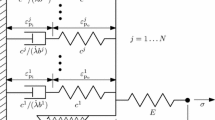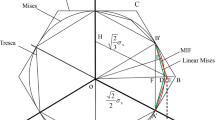Abstract
The present paper concerns the application of the upper bound theorem based on the work function to analyze metal forming processes. An advantage of this theorem formulation is that it provides a unified method for finding solutions for any yield criterion. In particular, any available kinematically admissible velocity field used in conjunction with the von Mises yield criterion can be utilized with no modification. On the other hand, an explicit function representing the work function associated with a given yield criterion cannot readily be expressed except for some particular cases. The approach proposed in the present paper is to assume a work function instead of a yield criterion. The paper is restricted to the work functions represented by first-order homogeneous functions. Moreover, the material is supposed to be isotropic and incompressible. The strength differential effect is neglected. Illustrative examples reveal the effect of the yield criterion on the limit load for axisymmetric extrusion and ring compression processes. These solutions utilize kinematically admissible velocity fields available in the literature.







Similar content being viewed by others
References
Prager W, Hodge PG Jr (1951) Theory of perfectly plastic solids. John Wiley & Sons, New York
Avitzur B (1980) Metal forming: the application of limit analysis. Marcel Dekker Inc, New York
Hill R (1956) New horizons in the mechanics of solids. J Mech Phys Solids 5:66–74. https://doi.org/10.1016/0022-5096(56)90009-6
Collins IF (1969) The upper bound theorem for rigid/plastic solids generalized to include Coulomb friction. J Mech Phys Solids 17:323–338. https://doi.org/10.1016/0022-5096(69)90021-0
Azarkhin A, Richmond O (1991) Extension of the upper bound method to include estimation of stresses. ASME J Appl Mech 58(2):493–498. https://doi.org/10.1115/1.2897211
Smith CC, Gilbert M (2022) The stress function basis of the upper bound theorem of plasticity. Int J Solids Struct 244–245:111565 https://doi.org/10.1016/j.ijsolstr.2022.111565
Alexandrov S, Rynkovskaya M (2022) Review of the upper bound method for application to metal forming processes. Metals 12:1962. https://doi.org/10.3390/met12111962
Abrinia K, Mirnia MJ (2010) A new generalized upper-bound solution for the ECAE process. Int J Adv Manuf Technol 46:411–421. https://doi.org/10.1007/s00170-009-2103-y
Yang X, Dong X, Wu Y (2017) An upper bound solution of forging load in cold radial forging process of rectangular cross-section billet. Int J Adv Manuf Technol 92:2765–2776. https://doi.org/10.1007/s00170-017-0303-4
Zhou W, Shi Z, Lin J (2018) Upper bound analysis of differential velocity sideways extrusion process for curved profiles using a fan-shaped flow line model. Int J Lightweight Mater Manuf 1:21–32. https://doi.org/10.1016/j.ijlmm.2018.03.004
Silva J, Santos PA, Unfer RK, Verran GO, Plaine AH (2021) Upper-bound analysis for equal channel angular pressing (ECAP) with an intersecting channel angle of 120°. Mater Res 24:e20210316 https://doi.org/10.1590/1980-5373-MR-2021-0316
Agarwal A, Singh S (2021) Upper bound analysis of closed-die forging of eccentrically-located SiCp AMC preforms. J Eng Appl Sci 25:275–285. https://doi.org/10.6180/jase.202204_25(2).0004
Zhang X, Li F, Wang Y, Chen Z (2022) An analysis for magnesium alloy curvature products formed by staggered extrusion (SE) based on the upper bound method. Int J Adv Manuf Technol 119:303–313. https://doi.org/10.1007/s00170-021-08167-z
Jo DS, Moon YH, Kim JH (2022) Upper bound analysis of friction stir spot welding of 6061–T6 aluminum alloys. Int J Adv Manuf Technol 120:8311–8320. https://doi.org/10.1007/s00170-022-09294-x
Farokhpey A, Parsa MH (2022) Analyzing the accumulative roll bonding deformation zone behavior by FEM, upper bound, and experimental methods. J Manuf Process 81:328–345. https://doi.org/10.1016/j.jmapro.2022.07.003
Wang GJ, Du HJ, Zhao DW, Liu XH, Wang GD (2009) Application of geometric midline yield criterion for strip drawing. J Iron Steel Res Int 16:13–16. https://doi.org/10.1016/S1006-706X(10)60020-9
Hosford WF (1972) A generalized isotropic yield criterion. ASME J Appl Mech 39(2):607–609. https://doi.org/10.1115/1.3422732
Billington EW (1988) Generalized isotropic yield criterion for incompressible materials. Acta Mech 72:1–20. https://doi.org/10.1007/BF01176540
Cazacu O, Revil-Baudard B, Chandola N (2018) Plasticity-damage couplings: From single crystal to polycrystalline materials, Springer. https://link.springer.com/book/https://doi.org/10.1007/978-3-319-92922-4
Szabó L, Jonas JJ (1995) Consistent tangent operator for plasticity models based on the plastic strain rate potential. Comput Meth Appl Mech Eng 128:315–323. https://doi.org/10.1016/0045-7825(95)00884-5
Kar P, Sahoo S, Das N (2000) Upper bound analysis for extrusion of T-section bar from square billet through square dies. Meccanica 35:399–410. https://doi.org/10.1023/A:1010361711579
Selles MA, Schmid SR, Sanchez-Caballero S, Perez-Bernabeu E, Reig MJ (2012) Upper-bound modelization of an ironed three-layered polymer-coated steel strip. Int J Adv Manuf Technol 60:161–171. https://doi.org/10.1007/s00170-011-3584-z
Haghighat H, Moradmand M (2013) Upper bound analysis of thick wall tubes extrusion process through rotating curved dies. Meccanica 48:1947–1958. https://doi.org/10.1007/s11012-013-9714-y
Zhang SH, Chen XD, Zhou J, Zhao DW (2016) Upper bound analysis of wire drawing through a twin parabolic die. Meccanica 51:2099–2110. https://doi.org/10.1007/s11012-016-0363-9
Hamidpour SP, Parvizi A, SeyyedNosrati A (2019) Upper bound analysis of wire flat rolling with experimental and FEM verifications. Meccanica 54:2247–2261. https://doi.org/10.1007/s11012-019-01066-4
Sheikhpour M, Hosseinipour SJ, Mirnia MJ (2020) Prediction of exit profile distortion in forward extrusion process using Riemann mapping theorem and upper bound method. Meccanica 55:1099–1118. https://doi.org/10.1007/s11012-020-01141-1
Bhutta M, Chitkara N (2001) Dynamic forging of splines and spur gear forms: a modified upper bound analysis that includes the effects of inertia and some experiments. Adv Manuf Technol 18:176–192. https://doi.org/10.1007/s001700170073
Barlat F, Chung K, Richmond O (1993) Strain rate potential for metals and its application to minimum plastic work path calculations. Int J Plast 9:51–63. https://doi.org/10.1016/0749-6419(93)90013-G
Hu G, Zhang K, Huang S, Ju JW (2012) Yield surfaces and plastic flow of 45 steel under tension-torsion loading paths. Acta Mech Solida Sin 25:348–360. https://doi.org/10.1016/S0894-9166(12)60032-9
Rossi M, Lattanzi A, Morichelli L, Martins JMP, Thuillier S, Andrade-Campos A, Coppieters S (2022) Testing methodologies for the calibration of advanced plasticity models for sheet metals: A review. Strain 58:e12426 https://doi.org/10.1111/str.12426
Chen J, Guan Z, Ma P, Li Z, Gao D (2020) Experimental extrapolation of hardening curve for cylindrical specimens via pre-torsion tension tests. J Strain Anal Eng Des 55:20–30. https://doi.org/10.1177/0309324719887863
Sliwa R (1991) A test determining the ability of different materials to undergo simultaneous plastic deformation to produce metal composites. Mater Sci Eng A 135:259–265. https://doi.org/10.1016/0921-5093(91)90573-6
Carvalho AP, Reis LM, Pinheiro RPRP, Pereira PHR, Langdon TG, Figueiredo RB (2022) Using plane strain compression test to evaluate the mechanical behavior of magnesium processed by HPT. Metals 12:125. https://doi.org/10.3390/met12010125
Nagpal V (1974) General kinematically admissible velocity fields for some axisymmetric metal forming problems. ASME J Eng Ind 96(4):1197–1201. https://doi.org/10.1115/1.3438495
Osakada K, Niimi Y (1975) A study on radial flow field for extrusion through conical dies. Int J Mech Sci 17:241–254. https://doi.org/10.1016/0020-7403(75)90006-5
Wilson WRD (1977) A simple upper-bound method for axisymmetric metal forming problems. Int J Mech Sci 19:103–112. https://doi.org/10.1016/0020-7403(77)90004-2
Alexandrov S, Lyamina E, Jeng YR (2017) A general kinematically admissible velocity field for axisymmetric forging and its application to hollow disk forging. Int J Adv Manuf Technol 88:3113–3122. https://doi.org/10.1007/s00170-016-9018-1
Avitzur B (1963) Analysis of wire drawing and extrusion through conical dies of small cone angle. ASME J Eng Ind 85(1):89–95. https://doi.org/10.1115/1.3667601
Alexandrov S, Mishuris G, Miszuris W, Sliwa RE (2001) On the dead-zone formation and limit analysis in axially symmetric extrusion. Int J Mech Sci 43:367–379. https://doi.org/10.1016/S0020-7403(00)00016-3
Alexandrov S, Richmond O (2001) Singular plastic flow fields near surfaces of maximum friction stress. Int J Non Linear Mech 36:1–11. https://doi.org/10.1016/S0020-7462(99)00075-X
Kudo H (1960) Some analytical and experimental studies of axi-symmetric cold forging and extrusion—I. Int J Mech Sci 2:102–127. https://doi.org/10.1016/0020-7403(60)90016-3
Kobayashi S (1964) Upper-bound solutions of axisymmetric forming problems—I. ASME J Eng Ind 86(2):122–126. https://doi.org/10.1115/1.3670467
Chitkara N, Butt M (2003) Axisymmetric rod extrusion through smooth and partially rough conical, cosine, and flat-faced circular dies: slip-line field solutions using numerical methods and some experiments. Int J Adv Manuf Technol 21:157–176. https://doi.org/10.1007/s001700300018
Acknowledgements
This work was made possible by the NCKU 90 and AAAA-A20-120011690136-2 programs. It was financially supported by the Ministry of Science and Technology of Taiwan (MOST 108-2221-E-006-228-MY3, 1 109-2923-E-006-005-MY3, 110-2124-M-006-005 and 111-2221-E-006-214) and Air Force Office of Science Research (AFOSR) under contract no. FA4869- 06-1-0056 AOARD 064053. Professor Yeau-Ren Jeng would like to acknowledge Medical Device Innovation Center (MDIC) and Intelligent Manufacturing Research Center (iMRC) from The Featured Areas Research Center Program within the framework of the Higher Education Sprout Project by the Ministry of Education (MOE) in Taiwan and AC2T research GmbH (AC2T) in Austria (COMET InTribology, FFG-No.872176).
Author information
Authors and Affiliations
Contributions
Sergei Alexandrov: Conceptualization, Methodology, Software, Validation, Investigation, Data curation, Writing – original draft. Elena Lyamina: Supervision, Writing – review & editing. Yeau-Ren Jeng: Conceptualization, Funding acquisition, supervision, Writing – review & editing.
Corresponding author
Ethics declarations
Conflict of interest
None of the authors has any conflict to interest.
Additional information
Publisher's note
Springer Nature remains neutral with regard to jurisdictional claims in published maps and institutional affiliations.
Rights and permissions
Springer Nature or its licensor (e.g. a society or other partner) holds exclusive rights to this article under a publishing agreement with the author(s) or other rightsholder(s); author self-archiving of the accepted manuscript version of this article is solely governed by the terms of such publishing agreement and applicable law.
About this article
Cite this article
Alexandrov, S., Lyamina, E. & Jeng, YR. Application of the upper bound theorem for metal forming processes considering an arbitrary isotropic pressure-independent yield criterion with no strength differential effect. Int J Adv Manuf Technol 126, 3311–3321 (2023). https://doi.org/10.1007/s00170-023-11312-5
Received:
Accepted:
Published:
Issue Date:
DOI: https://doi.org/10.1007/s00170-023-11312-5




